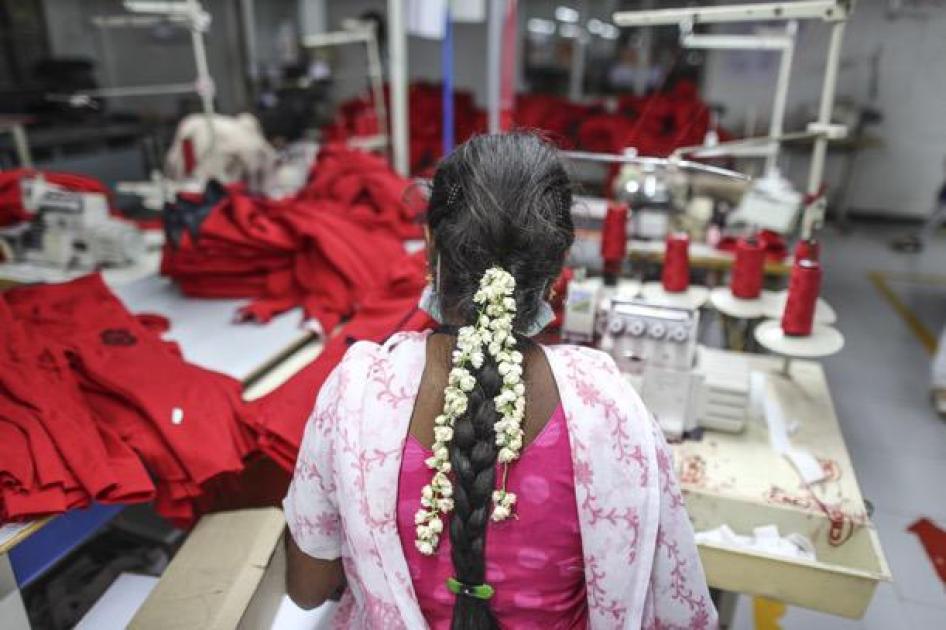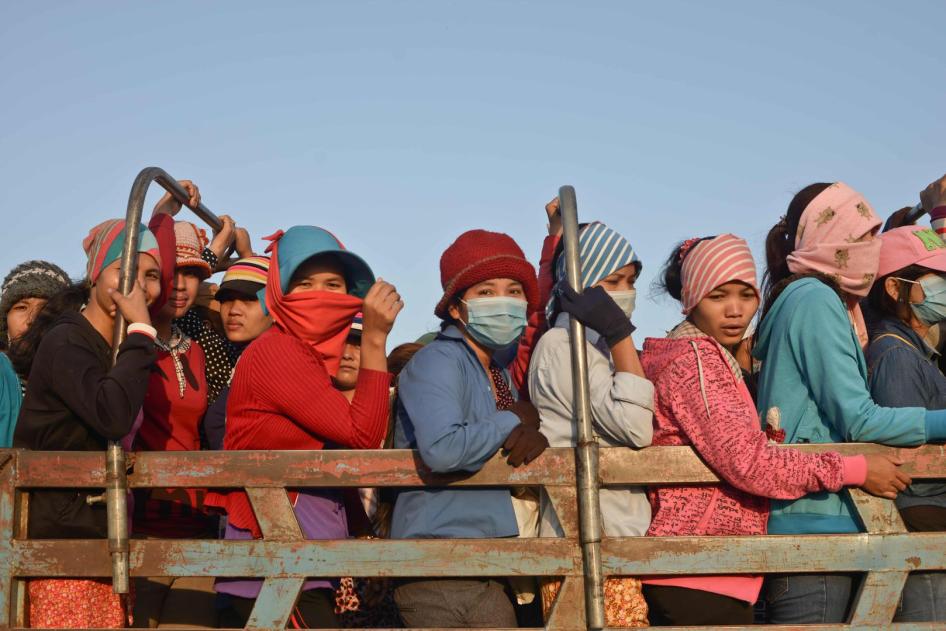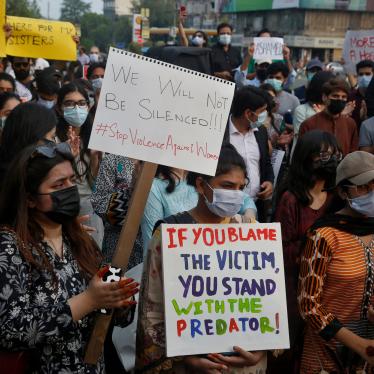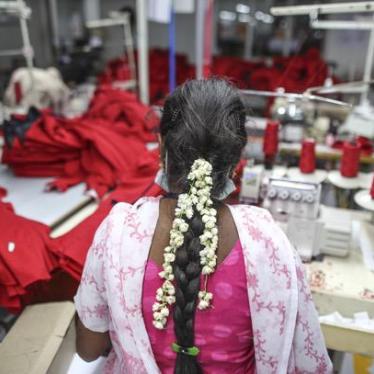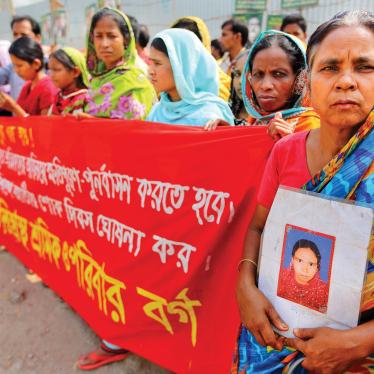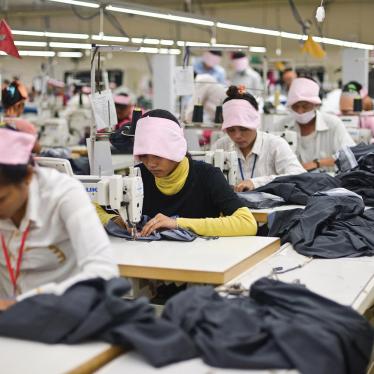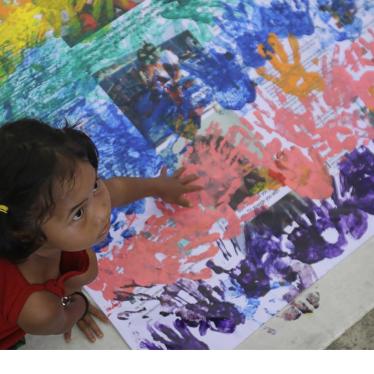Sexual Harassment in Garment Factories
Eleven women garment workers from a factory in southern India sent a hand-written letter to a local union in late 2016.[1] They wrote:
“The plight of women workers … we don’t have anyone who would listen to us…. We have to hear unbearable abuses at work from [name of the finishing section supervisor withheld]. ‘Do you come here to pluck your pubic hair?’ We are tired of hearing these kinds of abuses. We don’t have any other option but to let you know. We have come here to the city from another place to earn money. We too have self-respect and dignity. We have been complaining to the HR [human resources] but the HR manager is scared of him. We are 11 of us who have come together and complained. Please help us. We cannot put our names down because we are scared and want to live and work. They won’t let us be if we put our names down. We want justice…. Is it our fault that we are poor?”[2]
Union federation leaders who received the letter explained that the women were too scared to file formal complaints with the factory.[3] They said that the women feared retaliation both at the factory and back home. Being unmarried and from conservative families, the women were dependent on their families’ permission to work in the factories. If their families learned of the harassment they endured, they risked being told not to work outside the house.
In another Indian factory, Roja R., a married woman in her 30s, worked in the cutting division. She described how her supervisor stalked and repeatedly called her cell phone after work hours asking for sexual favors, promising that he would give her a lighter workload and sanction time-off whenever she wanted. When she complained to the factory’s administration, they said that he was a supervisor who had high productivity and told her such harassment was “normal” and that she needed to take it in stride.[4]
These are not isolated cases. Recent studies by nongovernmental organizations and news reports show that sexual harassment is rampant in garment factories in India, though efforts to prevent it and respond have also gradually increased.[5] Nor is India the only country where this is a pervasive and serious problem in garment factories.
In Pakistan, a married woman garment worker described how a male worker kept winking and making passes at an unmarried woman worker who was seated next to her. When the women complained to the factory’s human resources team, the factory warned the complainant and the accused, threatening to fire both of them.[6] In the same factory, managers threatened to transfer workers who refused overtime work to departments with more men where, according to female workers, the risk of harassment and humiliation was even higher. [7] Workers also told Human Rights Watch that the verbal abuse hurled at them was at its highest during peak production seasons, and felt it was done to make them work faster.[8]
In Cambodia, women workers said that the factory management’s harassment extended to situations outside the workplace. They cited examples where Chinese managers invited them to attend karaoke parties and drink with them, which they found uncomfortable but also difficult to refuse.[9] Women workers also complained about inappropriate sexual comments and advances, pinching, and other bodily contact by male managers and co-workers.[10]
In Bangladesh, Human Rights Watch has documented sexualized threats against women organizers by factory managers and supervisors.[11]
Verbal abuse is common in factories across different countries. For example, workers from different countries have described being humiliated with many insults such as “dog,” “donkey,” “prostitute,” “whore,” and “bitch.”[12] Women workers from different countries shared examples of line or floor supervisors and production managers insulting and humiliating them when they made requests regarding their sanitation or rest needs during menstrual cycles. For example, a group of women workers in Burma said that one of their key demands was for clean toilets in factories, especially when they were menstruating. But when they asked for clean toilets managers hurled verbal abuses at them.[13] Another group of workers in India said that male line supervisors sometimes made them feel uncomfortable by asking invasive and inappropriate questions about their sex lives when they asked to use the toilets or for breaks to relieve their menstrual cramps.[14] Human Rights Watch has also documented similar humiliating treatment in Bangladesh.[15]
Calling for a Binding ILO Convention
Millions of workers, mostly women, work in garment and footwear factories globally. Millions more work in other parts of the supply chain, from cotton fields to stores.
While India, Pakistan and many other countries at least have specific laws governing sexual harassment at work, 59 countries do not have any specific legal remedies for sexual harassment at work.[16] And the examples of India and Pakistan illustrate that even where there are laws governing sexual harassment at work, they are often not meaningfully implemented. Human Rights Watch interviews with workers in India and Pakistan revealed that many workers are not aware of their rights or of employer responsibilities under these laws, and have not undergone preventative trainings at work. And even if workers are vaguely familiar with the law, in the absence of strong anti-retaliation protection, they cannot safely seek meaningful protection.[17]
A global campaign is underway to develop a new international standard that will help prevent and respond to harassment and violence at work.[18] Unions and rights groups representing ordinary workers from different sectors, including factory workers, teachers, health workers, and those engaged in domestic work, have been advocating for a new binding International Labour Organization convention, accompanied by a recommendation, to address violence and harassment at work.
The advocacy for such a convention started before the 2017 and 2018 #MeToo waves but has been bolstered by that movement. Governments and business leaders committed to workplace equality should back these workers’ call. They should vote for a binding ILO Convention in 2019 when it is debated at the International Labour Conference in Geneva. That, in turn, will pave the way for rights groups around the world to champion overdue legal reforms or push for better enforcement of existing laws and workplace mechanisms.
The Limitations of Social Audits
In the absence of strong government regulation, many brands rely heavily on social audits to monitor conditions in the factories that produce their wares across complex global supply chains. These, however, are not equipped to capture and address sexual harassment or other forms of gender-based violence at work for numerous reasons.
Process not victim-friendly, does not guarantee a safe environment
Learning about women’s experiences of sexual harassment at work requires care and attention to designing a safe space for those willing to participate in interviews, including measures such as the option of workers to be accompanied by support persons into such interviews.[19]
Social audits are not designed to provide a safe environment to victims who experience sexual harassment. Experienced auditors from different countries who spoke with Human Rights Watch said that they randomly selected workers for interviews on-site as part of a social audit and conducted these interviews through a combination of group and individual interviews.[20] Some of the auditors Human Rights Watch interviewed said that it was difficult to conduct good interviews with workers on-site and said that it was preferable to interview workers off-site. They said that auditors did not have the freedom to design such audits because brands or factories paid a very limited amount of money and conducting interviews off-site needed more money and time.[21] Human Rights Watch recently interviewed two brand representatives who acknowledged that incorporating off-site interviews was more expensive and that the quality of a social audit was as good as the time given to it by auditors. As one noted blithely, “time costs money.”[22]
Conducting on-site interviews, even where the location of the interview within the factory is carefully chosen, does not allow workers to maintain full confidentiality. Workers who have participated in audit interviews say that the management knows precisely who is being interviewed or is easily able to find out since all line supervisors would know which of them has left the line to participate in interviews.
It is challenging to elicit reliable information in group settings for a number of reasons. Grouping workers together who may or may not be friends and trust each other, into a discussion which raises sexual harassment at work, does not take account of the needs of victims. Especially in conservative societies, group discussions with a mix of male and female workers cannot be a safe space in which women workers can discuss what they perceive as social taboos or sensitive subjects.
Human Rights Watch analyzed 50 third party audit reports of factories—most of them from Bangladesh, India, and Pakistan—issued between 2016 and 2018 where six large auditing firms had conducted the audits.[23] In each of the 50 reports, the auditors had interviewed workers in a combination of group and individual interviews, all on-site. None of the audit reports mentioned the gender composition of the group or individual interviews even though the reports provided the overall gender breakdown of workers. For example, a report would merely indicate that of 36 workers interviewed, 25 were women and 11 were men. But the reports did not disclose whether there were any all-women group discussions.
The audit team’s composition was not apparent in the report. None of the 50 reports made clear how many auditors were part of the team and whether the audit team included women auditors or interpreters even though women garment workers, especially from India, Pakistan, and Bangladesh, mostly come from conservative families and typically find it uncomfortable to discuss topics surrounding sexuality or gender with men. Some of the audit reports say they interviewed between 30 and 55 workers, and roughly about half of those workers were interviewed individually. But in the absence of more information about the time spent on each group discussion and individual interviews, which none of the audit reports give, it is almost impossible to know whether any of these interviews ventured into an in-depth discussion about sexual harassment at work. Given the long list of topics that social auditors are tasked with covering during the course of their interviews with workers, as evidenced by some of the scant summaries of individual interviews that appear in these reports, it appears unlikely that any of these discussions were carried in a way that would maximize the possibility of receiving credible information about harassment and violence at work.
No meaningful discussion of sexual harassment at workplace
Even though a majority of the audits reviewed by Human Rights Watch were full audits in countries with clear laws or court rulings against workplace harassment, these reports barely included any discussion of the issue.
Of the 50 third-party audit reports that Human Rights Watch analyzed, about 65 percent of them were semi-announced full audits, that is, detailed audits where the auditor informs the factory that they will be arriving to conduct audits but does not give the precise dates. In a few cases, the audit report did not mention whether they were announced, semi-announced, or unannounced. The remaining audit reports were semi-announced follow-up audits (that is, they were carried out after a full audit had already been conducted).
Even though India and Pakistan have had laws governing sexual harassment at work since 2013 and 2010, respectively, and Bangladesh’s High Court Division of the Supreme Court issued detailed guidelines against sexual harassment at work in 2009, almost none of the 50 reports made any mention of these laws or guidelines. Nor did they discuss the workplace systems needed to be set up under these laws or analyze the robustness of workplace systems or activities undertaken to combat harassment at work. For example, only one report from India made a passing reference to a “POSH [prevention of sexual harassment] committee” being present at the workplace, without presenting any more details. Any competent stakeholder consultation (usually specified as an important component of any social audit) which included women’s rights groups and experienced lawyers who conduct investigations into sexual harassment at work would likely reveal the shortcomings of the current social audit practices. For example, in at least two cases Human Rights Watch examined in India, workers complained that an external NGO invited to sit on a POSH committee at the workplace conducted hearings during which they were hostile to workers and were openly anti-union, berating workers about why they had approached unions or sought their assistance, bringing disrepute to factories. These preliminary findings reveal that factories were superficially complying with the law, but not meaningfully implementing it.[24]
Almost all the reports noted no abuse of any kind, including verbal abuse, even though such verbal abuse by line supervisors or other managers is widespread in the apparel industry.
Several auditors Human Rights Watch spoke with during the course of its research on social audits said that it was difficult for them to investigate or write about issues like violence, discrimination, and harassment at work, including sexual harassment. They said that all their findings are expected to be backed by “objective” evidence and both factories and brands asked them what evidence they had to report a major finding.[25]
For example, one former freelance auditor spoke at length to Human Rights Watch about the challenges of “independent corroboration.” He said it was difficult to independently corroborate allegations without doing in-depth offsite interviews with workers and others. He gave an example of a case from Bangladesh where he and his teams spent two weeks investigating how the factory management had beaten a worker on the head, leaving the worker with serious long-term detrimental impacts.
He explained how he paid out of pocket conducting meticulous investigation to present the kind of information that the brand and factory needed to see. He recalled, “We didn’t make any money on that audit and it took two weeks to write up properly and professionally.”
He said that unless companies paid sufficiently for every audit day without cutting the per day rate for audits, even independent auditors from smaller firms cannot afford to prioritize in-depth investigations to follow every allegation and corroborate information. He said, “You have to ignore a whole bunch of things you can sense is a problem. Because you have to pay all your staff salaries and what do you want to do? A three-week audit? It’s not just all the days going to the factories, but it’s also going to the slums to meet the workers, writing the notes, coaching all the staff.”[26]
The Need for Victim-Sensitive Systems and Anti-Retaliation Measures
Grievance redress mechanisms at the workplace should be responsive to the needs of victims and also incorporate anti-retaliation measures critical to combating workplace harassment. Through its research in multiple countries, Human Rights Watch has collected illustrative examples of retaliation inside garment factories for complaints raised by workers. While Human Rights Watch cannot speak to the prevalence of these practices, these examples reveal that current measures are not sufficient.
Even where an inquiry procedure exists, workers can experience the process itself as a form of harassment and be discouraged from using it. For example, a factory in India followed the practice of sending workers who filed a grievance to the “head office” for inquiries. The head office was located far away. The factory did not give workers transportation allowance to participate in the inquiry proceedings.[27]
In some cases, factory intimidation and harassment during inquiry proceedings can extend beyond a complainant herself, to her friends and witnesses. In effect, this isolates the complainant, making it difficult for her to find support persons to help or testify during the inquiry.[28] Factories may tell complainants they are not allowed to bring a union leader to accompany them to inquiry proceedings, leaving uneducated and poor workers to sit through inquiry proceedings without support persons of their choice who are equipped with good knowledge of laws and procedures. For example, in one case, a woman complainant who alleged sexual harassment in a garment factory sought a male colleague’s assistance to testify as a witness. The union assisting them reported to Human Rights Watch that both she and the male colleague faced harassment.[29]
Groups that own more than one factory issue punitive transfers, forcing workers to go work in a different factory owned by the same group, making the commute harder, and isolating them from friends.[30]
Finally, factories may simply retaliate against workers who attempt to file grievances by dismissing them or not renewing their contract. Workers on short-term contracts or daily wage workers were particularly at risk of dismissal or non-renewal of contract.[31]
Taken together, all of this points to the need for rigorous and consistent government action to prevent, detect and address violence and harassment at work. Audit-centered company due diligence efforts cannot substitute for this. A binding ILO convention is the best path towards clear standards and robust, government-led protections and responsibilities for employers.
Recommendations to Global Apparel and Footwear Companies
- Publicly support the drive towards a binding ILO convention to tackle violence and harassment at work.
- Publish the company’s global factory lists in accordance with the Transparency Pledge.[32]
- Design brand-level grievance redress mechanisms with the participation of workers, unions, and labor advocates, ensuring that these mechanisms are also equipped to tackle sexual harassment at work.
- Carry out periodic studies to examine gender-based violence and harassment at work in every production country. Ensure that women workers, unions, and local women’s rights groups with experience in tackling workplace harassment are actively involved in designing the studies and are able to provide information safely. These studies should allow women and union leaders to give confidential feedback about any complaints systems at work, ease of access and use of such mechanisms, and anti-retaliation protection measures.
- Brands should ask and map out as part of sourcing and compliance information, whether the factory they are placing orders with has sister companies owned by the same parent company. This would go a long way to help detect retaliation against workers.
- Take steps to examine and redress brands’ purchasing practices to prevent and mitigate risks of abusive practices in the supply chain. In particular, examine all practices that reduce a factory’s time available for bulk production. These include brand approvals for materials and samples, producing technical packs for designs on time, and tracking the difference between projected and actual orders.
[1] Human Rights Watch group interview with two union federation officials from Garment Labour Union, Bangalore, May 9, 2018. The letter was not dated. The union leaders estimated that they received it towards the end of 2016, about six months before April 2017, when they received another complaint of harassment from a factory owned by the same group.
[2] Letter written by 11 anonymous women workers, undated, on file with Human Rights Watch.
[3] Human Rights Watch group interview with union federation officials from Garment Labour Union, Bangalore, May 9, 2018.
[4] Human Rights Watch interview with Roja R. (pseudonym), garment worker, Mysore, May 10, 2018.
[5] See for example, Sisters for Change, Munnade, “Eliminating Violence Against Women at Work,” June 2016, http://sistersforchange.org.uk/wp-content/uploads/2016/06/SFC_WomenatWork_FullReport_25June2016.pdf (accessed January 29, 2018); Rohini Mohan, “Bengaluru garment hub’s dirty secret: Sexual harassment in the workplace,” Scroll.in, June 27, 2017, https://scroll.in/article/840363/bengaluru-garment-hubs-dirty-secret-sexual-harassment-at-the-workplace; Sreenivasan Jain et al., “How Sexual Harassment Has Scarred Women in India’s Garment Industry,” NDTV, July 10, 2016 https://www.ndtv.com/india-news/how-sexual-harassment-has-scarred-women-in-indias-garment-industry-1429156 (accessed January 29, 2019).
[6] Human Rights Watch interview with Jina Reza (pseudonym), Lahore, May 18, 2018.
[7] Human Rights Watch interview with Nazma Akram (pseudonym), Lahore, May 18, 2018.
[8] Human Rights Watch interviews with Fawzia Khan, Nazma Akram, and Jina Reza (pseudonyms), Lahore, May 18, 2018.
[9] Human Rights Watch interviews with 10 garment workers from two factories in Cambodia, Phnom Penh, May 12, 2013.
[10] Human Rights Watch, “Work Faster or Get Out: Labor Rights Abuses in Cambodia’s Garment Industry,” March 2015, https://www.hrw.org/sites/default/files/reports/cambodia0315_ForUpload.pdf (accessed January 29, 2019).
[11] Human Rights Watch, “Whoever Raises their Head Suffers the Most: Workers’ Rights in Bangladesh’s Garment Factories,” April 2015, http://features.hrw.org/features/HRW_2015_reports/Bangladesh_Garment_Factories/ (accessed January 29, 2019).
[12] Human Rights Watch, Work Faster or Get Out, March, 2015; Whoever Raises their Head Suffers the Most, April 2015; Human Rights Watch interviews with 20 workers from 5 factories in India supplying international brands, India, May 2018; Fair Wear Foundation, “Violence and Harassment Against Women and Men in the Global Garment Supply Chain,” https://www.fairwear.org/wp-content/uploads/2018/03/FWF-ILO-submission-final.pdf (accessed January 29, 2019). In Fair Wear Foundation’s survey of 658 women in 35 Indian and Bangladeshi factories, 75 per cent said that regular verbal abuse occurred in their factory, most of which was sexually explicit. Better Work, “The Case Against Verbal Abuse in Garment Factories: Evidence from Better Work,” https://betterwork.org/dev/wp-content/uploads/2016/11/Research-brief-Verbal-V2-WEB.pdf presents findings and conclusions from Indonesia, Jordan, and Vietnam.
[13] Human Rights Watch group interview with 11 garment workers, Yangon, May 19, 2018.
[14] Human Rights Watch group interviews with 3 women workers and 5 women workers from the same factory, Mysore, May 11, 2018.
[15] Human Rights Watch, Whoever Raises their Head Suffers the Most, April 2015.
[16] World Bank, Women Business and Law, 2018, http://documents.worldbank.org/curated/en/926401524803880673/Women-Business-and-the-Law-2018 (accessed January 29, 2019).
[17] Human Rights Watch, “No Room to Bargain: Unfair and Abusive Labor Practices in Pakistan,” January 2019, https://www.hrw.org/report/2019/01/23/no-room-bargain/unfair-and-abusive-labor-practices-pakistan (accessed January 29, 2019); Human Rights Watch additional interviews with workers and local nongovernmental organizations in Pakistan, May 2018; Human Rights Watch group and individual interviews with 20 workers and three union leaders, India, May 2018.
[18] Human Rights Watch, “Ending Violence and Harassment at Work: The Case for Global Standards,” May 2018, https://www.hrw.org/sites/default/files/news_attachments/2018_hrw_ilo_brochure.pdf (accessed January 29, 2019).
[19] See for example, CARE, “I Know I Cannot Quit: The Prevalence and Productivity Cost of Sexual Harassment to the Cambodian Garment Industry,” March 2017, https://www.care.org.au/wp-content/uploads/2017/04/SHCS_Full_Technical_Report_March_2017.pdf. The report describes the importance of creating safe spaces and offering women the option of bringing support persons to sit through discussions about sexual harassment.
[20] Human Rights Watch phone interviews with 10 auditors who had experience conducting audits in India, Pakistan, Indonesia, Sri Lanka, Myanmar, and Thailand, locations withheld, April 2018 to November 2018.
[21] Human Rights Watch interviews with six auditors who had experience conducting social audits in Bangladesh, Pakistan, Thailand, Burma, and Indonesia, locations withheld, April to November 2018.
[22] Human Rights Watch phone interviews with one former and a current brand compliance representative from two different European brands (who chose to remain anonymous), Europe, July 2018, November 2018, and January 2019.
[23] Human Rights Watch received these 50 reports from a European brand. All factory names were omitted by the brand while sharing the audit reports. Two social audit reports were from Myanmar and one from Cambodia.
[24] Human Rights Watch interviews with workers and union officials from Garment Labour Union, Bangalore, May 2018.
[25] Human Rights Watch interviews with six auditors who had experience conducting social audits in Bangladesh, Pakistan, Thailand, Burma, and Indonesia, locations withheld, April to November 2018.
[26] Human Rights Watch interview with an auditor (who chose to remain anonymous), South East Asia, May 2018.
[27] Human Rights Watch interviews with union leaders from the Garment Labour Union, and workers from two factories in India, Bangalore, May 2018.
[28] Ibid.
[29] Ibid.
[30] Human Rights Watch group interview with two union federation officials from Garment Labour Union, Bangalore, May 2018. These officials gave three examples where workers were punitively transferred to a different factory after they filed complaints of harassment more broadly (not sexual harassment).
[31] Human Rights Watch, Work Faster or Get Out: Labor Rights Abuses in Cambodia’s Garment Industry, March 2015.
[32] Human Rights Watch et al., “Follow the Thread: The Need for Supply Chain Transparency in the Garment and Footwear Industry,” April 2017, https://www.hrw.org/report/2017/04/20/follow-thread/need-supply-chain-transparency-garment-and-footwear-industry (accessed January 29, 2019).
